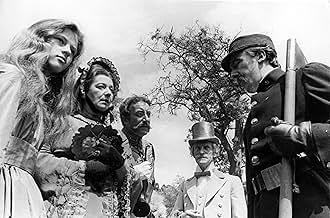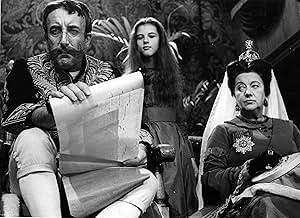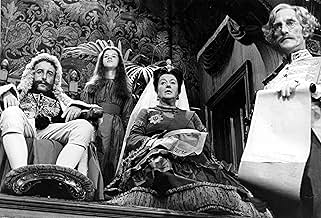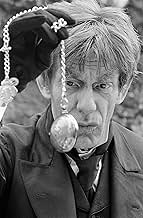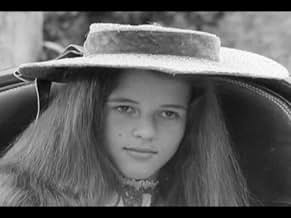IMDb-BEWERTUNG
6,7/10
1098
IHRE BEWERTUNG
Füge eine Handlung in deiner Sprache hinzuA girl named Alice falls down a rabbit-hole and wanders into the strange Wonderland.A girl named Alice falls down a rabbit-hole and wanders into the strange Wonderland.A girl named Alice falls down a rabbit-hole and wanders into the strange Wonderland.
- Regie
- Drehbuch
- Hauptbesetzung
Jo Maxwell Muller
- Alice's Sister
- (as Jo Maxwell-Muller)
Michael Redgrave
- Caterpillar
- (as Sir Michael Redgrave)
Anthony Trent
- Fish Footman
- (as Tony Trent)
- …
Wilfrid Lawson
- Dormouse
- (as Wilfred Lawson)
Empfohlene Bewertungen
I'm not sure I completely buy Jonathan Miller's account of the book, but his interpretation (as he explains it on the commentary track) is pretty wonderful on balance. It's funny, surprising, beautiful and mostly about the nature of dreams. The cast, for fans of British movies and TV of the period, may have never been equaled. There's one from "Help", there's one from "A Hard Day's Night", there's the midget from "The Prisoner!" Wonderful. The only real question is "Where's Dudley Moore?" At any rate, I just found out about this movie, it's only been out on DVD for a year or two but it's one I think I will always treasure.
This is an experimental TV-movie from the BBC's "Wednesday Play" anthology. That series was always willing to risk trying something different, and this ambitious, low-budget "Alice" is certainly different. I don't exactly *enjoy* this film, but it's certainly fascinating.
I appreciate it as an experiment in what television could do. I admire the cast of iconic and talented Britons who wouldn't normally coincide in the same project: Peter Sellers, John Gielgud, Leo McKern (in drag as the Duchess), Michael Redgrave, Peter Cook, Wilfrid Brambell, Alan Bennett, Malcolm Muggeridge, etc.
I also admire the creativity it took to imagine this quintessentially British tale accompanied by Ravi Shankar music.
Some viewers may find the film too creepy and surreal, but the original book is pretty disturbing to begin with. This film is fairly incoherent, but then so is the book, which follows the ever-shifting logic of a dream.
The biggest problem (aside from pacing that now seems too leisurely) is that Miller's production assumes you already know what's going on. For instance, it assumes you know that the two men dressed as... um... men are actually the Gryphon and the Mock Turtle.
In other words, this is an "Alice" for people who are already overdosed on adaptations of "Alice," and who might appreciate a weirdly different take on the familiar story. Or to narrow that audience a bit, people age 12 and up who might appreciate a different take on the story.
I appreciate it as an experiment in what television could do. I admire the cast of iconic and talented Britons who wouldn't normally coincide in the same project: Peter Sellers, John Gielgud, Leo McKern (in drag as the Duchess), Michael Redgrave, Peter Cook, Wilfrid Brambell, Alan Bennett, Malcolm Muggeridge, etc.
I also admire the creativity it took to imagine this quintessentially British tale accompanied by Ravi Shankar music.
Some viewers may find the film too creepy and surreal, but the original book is pretty disturbing to begin with. This film is fairly incoherent, but then so is the book, which follows the ever-shifting logic of a dream.
The biggest problem (aside from pacing that now seems too leisurely) is that Miller's production assumes you already know what's going on. For instance, it assumes you know that the two men dressed as... um... men are actually the Gryphon and the Mock Turtle.
In other words, this is an "Alice" for people who are already overdosed on adaptations of "Alice," and who might appreciate a weirdly different take on the familiar story. Or to narrow that audience a bit, people age 12 and up who might appreciate a different take on the story.
Probably will remain in my top 3 Alice in Wonderland film adaptations (it only covers the first book), just below Svankmajer's wonderfully surreal stop-motion version, titled Alice, and I'm somewhat ambivalent about whether I prefer the Disney version or not-it's nicely colored and the characters are more similar to the drawings In Carroll's book, but it has the goofiness of a Disney film, of course. This adaptation is quite faithful to the original book, though a few scenarios might have been removed for time or were altered in some way, but most of the dialogue remains the same.
I was expecting it to feel more like a big studio production, and while the production values were quite good, it's not reminiscent of a Hollywood film or the British equivalent. It has the aura of a B&W art film-and the girl playing Alice (makes me think of a French New Wave heroine), who never smiles, often scowls, is rather sullen, often avoids eye contact or talks while not even looking at the character she's speaking to, and is clearly older than 7 (I believe that was the stated age of Alice in the book). Though she's a bit sassy in the book and not a push over or anything, her behavior seems altered quite a bit based off my, admittedly somewhat time-eroded, memories of Alice and Wonderland. The other change is, while the film is quite faithful in terms of the scenes adapted, the actors are all humans with no attempts to dress them up as the curious assortment of talking animals, odd creatures, and flat card-like men and women found in the book.
The choice of sitar music, with occasional accompaniment, by Ravi Shankar (and someone else I hadn't heard of on oboe) was an interesting and surprisingly fitting choice. I always imagined Canterbury prog or some old folk music with flutes.
In some sense I think it has a more dream-like continuity than the book, because the whimsical passages of Carroll lend's the novel a more structured and deliberate quality, compared to the way the scenes flow and our edited in this version.
I was expecting it to feel more like a big studio production, and while the production values were quite good, it's not reminiscent of a Hollywood film or the British equivalent. It has the aura of a B&W art film-and the girl playing Alice (makes me think of a French New Wave heroine), who never smiles, often scowls, is rather sullen, often avoids eye contact or talks while not even looking at the character she's speaking to, and is clearly older than 7 (I believe that was the stated age of Alice in the book). Though she's a bit sassy in the book and not a push over or anything, her behavior seems altered quite a bit based off my, admittedly somewhat time-eroded, memories of Alice and Wonderland. The other change is, while the film is quite faithful in terms of the scenes adapted, the actors are all humans with no attempts to dress them up as the curious assortment of talking animals, odd creatures, and flat card-like men and women found in the book.
The choice of sitar music, with occasional accompaniment, by Ravi Shankar (and someone else I hadn't heard of on oboe) was an interesting and surprisingly fitting choice. I always imagined Canterbury prog or some old folk music with flutes.
In some sense I think it has a more dream-like continuity than the book, because the whimsical passages of Carroll lend's the novel a more structured and deliberate quality, compared to the way the scenes flow and our edited in this version.
"Who am I?" asks a shabbily dressed, scruffy-haired incarnation of Lewis Carroll's immemorial little girl lost. Of course, the answer's come in various forms ever since such cinematic endeavors as Cecil Hepworth's "Alice in Wonderland," made in 1903 (at 12 minutes, the longest British film of the day; Cecil, you'll remember, two years later made the world's first "dog star" with his monumentally successful "Rescued by Rover," which was shown so many times that the celluloid literally deteriorated, forcing the filmmakers to completely "re-produce" it two more times; his "Alice in Wonderland," unfortunately, did not boast such a success, and thus all we have today is something that looks as though it tumbled down the rabbit hole one too many times). But enough of this sluice at the bottom of the March Hare's treacle well, eh?
Made for the BBC's The Wednesday Play television series, Jonathan Miller's take on the subject matter is, as is traditionally the case, a unique one. With a budget approximating nothing more than his usual "taped stage plays" for which he previously gained great renown (think preter-PBS), Miller decided to illustrate what Alice would have gone through had all of her nonsensical dreams been steeped in the quotidian reality of her ordinary life. There are no talking birds, no storytelling mock turtles, no dormice living in teacups. In fact, short of a crude cut-out superimposition of a very ordinary looking "Cheshire cat" flying in the sky (a la the Teletubbies' eerily omniscient baby in the sun), there's really no special effects or anything that would evince this one of being the least bit chimerical
that is, unless you know the story of Alice in Wonderland already. Ostensibly, what Miller is doing here is showing us the curious, towheaded girl's "adventures" set in a world where people merely sound like birds and look like supine caterpillars sitting loftily back in their Victorian chairs and wondering aloud, "Who are you?" Imagine Wizard of Oz, but without all the costumes, flying monkeys, and mercurial trees pulling at the heroine's hair.
Suddenly, we along with Alice find ourselves in a land where we were already (that is, of course, if we were a haughty 11-year-old girl wandering lackadaisically through our castellated house in the late 19th century). What we see is the "reality" of the dreamworld of Alice's waking life.
And this is exactly what Miller captures in this version of the epic "children's" tale for stoners and mathematicians. In fact, the only real sense of "dreamland" we can extract from Miller's vision is a kind of proto-Gilliam realm of canted camera angles and unsettling juxtapositions of close-up faces in deep-focus environments (think Brazil or particularly Fear & Loathing in Las Vegas, which clearly owes both its visual and aural style to Mr. Miller). Truthfully, after watching this late 60's stark, black-and-white opus (if ever so disjointed and flawed), one would have to assume that Terry Gilliam took much of his artistic sensibility from what is definitely far more than a simple made-for-TV broadcast.
With a quadrille of British mainstaysPeter Cook as the Mad Hatter, Sir John Gielgud as the Mock Turtle, Alan Bennett as the Mouse, an uncredited Eric Idle, and the King of Hearts himself, Peter SellersJonathan Miller, with lilting, ethereal score by Ravi Shankar, does what no other director has done to date with this timeless urtext: he shows us what would have happened had Alice stayed awake during her infamous tour through dreamland.
PS: If this one doesn't do it for you, try out Czech filmmaker Jan Svankmajer's nightmarish Alice (1988), which must be the most haunting adaptation of Alice's adventures yet put on celluloid.
Made for the BBC's The Wednesday Play television series, Jonathan Miller's take on the subject matter is, as is traditionally the case, a unique one. With a budget approximating nothing more than his usual "taped stage plays" for which he previously gained great renown (think preter-PBS), Miller decided to illustrate what Alice would have gone through had all of her nonsensical dreams been steeped in the quotidian reality of her ordinary life. There are no talking birds, no storytelling mock turtles, no dormice living in teacups. In fact, short of a crude cut-out superimposition of a very ordinary looking "Cheshire cat" flying in the sky (a la the Teletubbies' eerily omniscient baby in the sun), there's really no special effects or anything that would evince this one of being the least bit chimerical
that is, unless you know the story of Alice in Wonderland already. Ostensibly, what Miller is doing here is showing us the curious, towheaded girl's "adventures" set in a world where people merely sound like birds and look like supine caterpillars sitting loftily back in their Victorian chairs and wondering aloud, "Who are you?" Imagine Wizard of Oz, but without all the costumes, flying monkeys, and mercurial trees pulling at the heroine's hair.
Suddenly, we along with Alice find ourselves in a land where we were already (that is, of course, if we were a haughty 11-year-old girl wandering lackadaisically through our castellated house in the late 19th century). What we see is the "reality" of the dreamworld of Alice's waking life.
And this is exactly what Miller captures in this version of the epic "children's" tale for stoners and mathematicians. In fact, the only real sense of "dreamland" we can extract from Miller's vision is a kind of proto-Gilliam realm of canted camera angles and unsettling juxtapositions of close-up faces in deep-focus environments (think Brazil or particularly Fear & Loathing in Las Vegas, which clearly owes both its visual and aural style to Mr. Miller). Truthfully, after watching this late 60's stark, black-and-white opus (if ever so disjointed and flawed), one would have to assume that Terry Gilliam took much of his artistic sensibility from what is definitely far more than a simple made-for-TV broadcast.
With a quadrille of British mainstaysPeter Cook as the Mad Hatter, Sir John Gielgud as the Mock Turtle, Alan Bennett as the Mouse, an uncredited Eric Idle, and the King of Hearts himself, Peter SellersJonathan Miller, with lilting, ethereal score by Ravi Shankar, does what no other director has done to date with this timeless urtext: he shows us what would have happened had Alice stayed awake during her infamous tour through dreamland.
PS: If this one doesn't do it for you, try out Czech filmmaker Jan Svankmajer's nightmarish Alice (1988), which must be the most haunting adaptation of Alice's adventures yet put on celluloid.
Jonathan Miller's version of "Alice In Wonderland" is at times both very beautiful to watch and somehow mildly boring to sit through. Boring perhaps because of the detached performance of Anne-Marie Mallik who plays Alice. Jonathan Miller has Mallik play Alice as a girl who watches her own dream fantasy of 'Wonderland' from the outside of the looking glass rather than someone who has gone through the looking glass. It's almost as if Alice knows that she's dreaming and is able to control her own dreams, yet is somehow bored and barely amused with the dream world she has created. Mallick walks through 'Wonderland' as a somnambulist chaser. Transitions from scene to scene include drowsy dissolves or close ups of Mallick in all of her hair brushed beauty staring away from the camera. Large sections of Mallik's dialog are heard by way of voice over while the other actors work around her silence acting in the gaps.
One of "Alice's" strengths is in the rest of the compiled cast. There are some very good performances, most notably Wilfred Brambell as the White Rabbit, John Gielgud as the Mock Turtle, Peter Cook as the Mad Hatter and Michael Gough as the March Hare and of course, Peter Sellers as the King of Hearts. It's too bad that with the two most brilliant comedic minds of the mid 1960's, that of Peter Sellers and Peter Cook, that more freedom wasn't given to explore the comic possibilities these two could give to the story. But having this comedic freedom was not to be part of Miller's vision. Miller describes on the audio commentary of the DVD his dislike for two ad-libs provided by Cook and Sellers. Apparently because of the tight shooting schedule, there wasn't any time for lengthy re-shoots of the two ad-libs that made it into the final cut. Thank goodness for small compromises, I would hate to think of anything Sellers or Cook did on film that would be lost to the cutting room floor.
Even though Jonathan Miller's artistic resume up until the release of this film could boast of a man steeped in the comedic tradition of the Cambridge Footlights and the ground breaking satirical group 'Beyond The Fringe', his version of "Alice In Wonderland" surprisingly finds itself mostly miles away from humor. However, what it lacks in humor it makes up for in the haunting sitar backing music by Ravi Shankar.
This isn't a bad movie, just terribly frustrating and surprisingly boring at times. The good news is that it's only an hour long. This is a trip you should take; just don't get your hopes up too high.
For fans of Monty Python, look for Eric Idle in the choir near the end of the film. He appears at around the 58-minute mark.
7/10 Clark Richards
One of "Alice's" strengths is in the rest of the compiled cast. There are some very good performances, most notably Wilfred Brambell as the White Rabbit, John Gielgud as the Mock Turtle, Peter Cook as the Mad Hatter and Michael Gough as the March Hare and of course, Peter Sellers as the King of Hearts. It's too bad that with the two most brilliant comedic minds of the mid 1960's, that of Peter Sellers and Peter Cook, that more freedom wasn't given to explore the comic possibilities these two could give to the story. But having this comedic freedom was not to be part of Miller's vision. Miller describes on the audio commentary of the DVD his dislike for two ad-libs provided by Cook and Sellers. Apparently because of the tight shooting schedule, there wasn't any time for lengthy re-shoots of the two ad-libs that made it into the final cut. Thank goodness for small compromises, I would hate to think of anything Sellers or Cook did on film that would be lost to the cutting room floor.
Even though Jonathan Miller's artistic resume up until the release of this film could boast of a man steeped in the comedic tradition of the Cambridge Footlights and the ground breaking satirical group 'Beyond The Fringe', his version of "Alice In Wonderland" surprisingly finds itself mostly miles away from humor. However, what it lacks in humor it makes up for in the haunting sitar backing music by Ravi Shankar.
This isn't a bad movie, just terribly frustrating and surprisingly boring at times. The good news is that it's only an hour long. This is a trip you should take; just don't get your hopes up too high.
For fans of Monty Python, look for Eric Idle in the choir near the end of the film. He appears at around the 58-minute mark.
7/10 Clark Richards
Wusstest du schon
- WissenswertesMost of this movie was shot with a 9mm camera lens.
- PatzerIn the scenes with the Mock Turtle, his legs are crossed in all the long shots, but in close-up shots, his legs are in a completely different position; without there being enough time to have changed them from one shot and another.
- Crazy CreditsThe end credits use Lewis Carroll's original ink drawings from his handwritten manuscript (called 'Alice's Adventures Under Ground') now in the British Library.
- VerbindungenFeatured in The Worlds of Fantasy: The Child Within (2008)
Top-Auswahl
Melde dich zum Bewerten an und greife auf die Watchlist für personalisierte Empfehlungen zu.
Details
- Erscheinungsdatum
- Herkunftsland
- Offizieller Standort
- Sprache
- Auch bekannt als
- Alice Harikalar Diyarında
- Drehorte
- Produktionsfirma
- Weitere beteiligte Unternehmen bei IMDbPro anzeigen
- Laufzeit1 Stunde 12 Minuten
- Farbe
- Sound-Mix
- Seitenverhältnis
- 1.33 : 1
Zu dieser Seite beitragen
Bearbeitung vorschlagen oder fehlenden Inhalt hinzufügen

Oberste Lücke
By what name was Alice in Wonderland (1966) officially released in Canada in English?
Antwort



